In these tumultuous times, the need for greater diversity, equity and inclusion (DEI) is in the news almost every day. One of the best ways to raise tolerant, accepting and empathetic children ready to thrive in life is to start early, incorporating inclusion and anti-bias into early childhood education curriculum for infants, toddlers and their families.
Stay Connected
Sign up to receive news, helpful tools and learn about how you can help our youngest learners.
Danielle Jordan, a school director of Educare Chicago, recently shared the early childhood school’s DEI best practices, starting with the fundamentals.
Teachers at Educare Chicago incorporate songs, storytelling and books into the curriculum. Some of her favorites include:
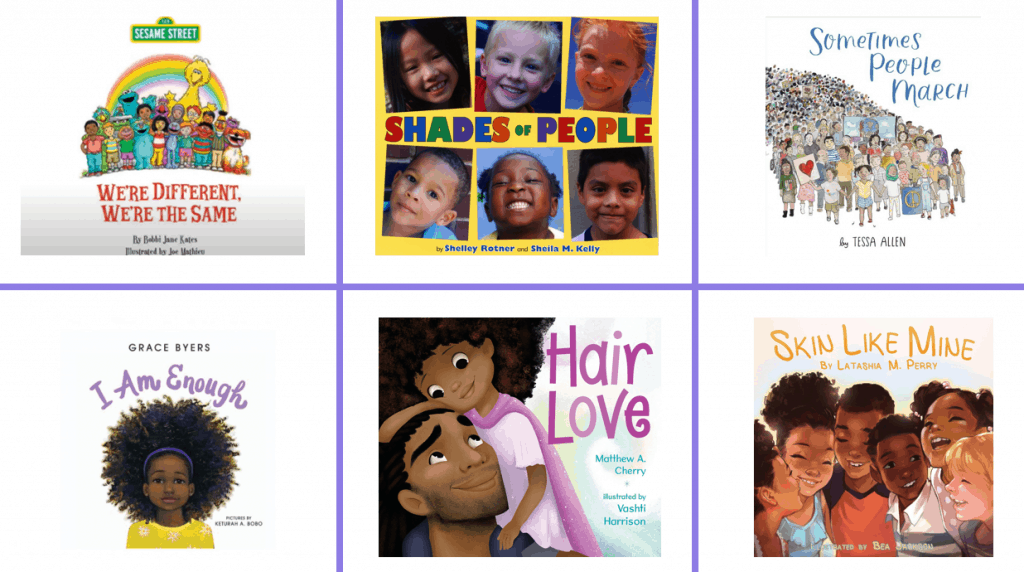
This approach to developing a child’s sense of confidence in their personal and social identities (e.g., gender, ethnic and religious) aligns with the National Association for the Education of Young Children’s (NAEYC) anti-bias education. As a result, children feel grounded in who they are without a need to be superior to anyone else. The approach also emphasizes a teacher’s capacity to help a child recognize how they are simultaneously different and similar to others, which helps children foster an ability to comfortably and empathetically engage with people from all backgrounds.
We encourage students to share what is distinct about their families, how they celebrate special occasions and what is important to them.
Danielle Jordan, School Director, Educare Chicago
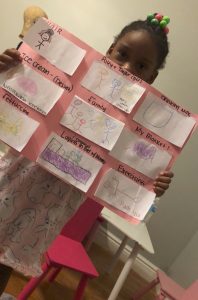 In a recent activity, children recently made posters showcasing their cultural heritage, as well as their similarities and differences. “The students were able to share and be proud of what makes them unique… your hair may be in ponytails, while my hair is in locks. The simple rule is we would like to treat people fairly and acknowledge that we are different but we’re also the same and need to show each other respect,” Jordan continues.
In a recent activity, children recently made posters showcasing their cultural heritage, as well as their similarities and differences. “The students were able to share and be proud of what makes them unique… your hair may be in ponytails, while my hair is in locks. The simple rule is we would like to treat people fairly and acknowledge that we are different but we’re also the same and need to show each other respect,” Jordan continues.
This focus on respect and appreciation for inclusion is particularly important during this time of racial unrest. “The way that we address the societal environment is by talking about community, family, culture and heritage,” says Jordan.
To help talk about these topics, staff at Educare Chicago have incorporated Sesame Street’s “We’re Different, We’re the Same” segment into their curriculum, as well as the book “Sometimes People March” by Tessa Allen.
We are doing exactly what our name says… We are starting early and building foundations that I hope will give the students what they need to go on.
Danielle Jordan, School Director, Educare Chicago
Educare Chicago teachers also help students learn how to process big emotions such as sadness and anger, while emphasizing that people express feelings in a variety of ways to encourage an appreciation for personality differences. The school’s Wellness Specialists also connect with parents to let them know where their children are from a socioemotional perspective and offer guidance for development.
Intensive family engagement is a core tenet of the school’s approach, meaning the school’s inclusive curriculum also extends to children’s first teachers: their parents and caregivers. Staff provide parents with book recommendations, including those outlined above to help encourage at-home discussions about DEI. There are also parent support groups and a Parent Committee to help parents to build strong relationships with staff and one another.
Jordan has already seen the impact of their work. Recently, students celebrated a very shy classmate for stepping outside his comfort zone to give a presentation to the entire school about his pet snake.
Learn more about how to address race and identity with children by reading our National Racial Day of Healing blog post.
What We Do
Our comprehensive approach applies our deep expertise in program, policy and research so that children, families and educators can thrive.
Support Our Work
Together, when we start early, we can close the opportunity gap and ensure every child has a chance to reach their full potential.
Our Impact
Learn more about how we are supporting children, families and early childhood professionals as we improve the state of early learning in America.
Separation anxiety and the behaviors that manifest from it are specific to each child. Educators must honor the differences in each child and the culture of the school or center where they work when partnering with parents to help a child cope with separation anxiety. While the strategy will vary for each child, the goal remains the same: helping them feel safe and secure in the new environment so that they can learn.
The thoughts and opinions expressed in this article are informed by what Start Early experts and Educare Chicago teachers have found to be successful ways of mitigating separation anxiety in the classroom. While there are many opinions on this broad topic, one recurrent theme is the importance of establishing a routine.
Stay Connected
Sign up to receive news, helpful tools and learn about how you can help our youngest learners.
Helping children to create routines within their daily life is one of the best ways to teach confidence, self-discipline and cooperation—skills that later lead to the development of strong coping mechanisms. Such skills enable children to more easily navigate unexpected changes and adjust to unfamiliar environments.
- Visit the School or Center. Children act out stresses from separation anxiety in a number of different ways. One way to reduce separation anxiety is to introduce them, in advance, to the school or child care center they will attend. If the school or center allows for pre-school year visits, take advantage to get your child acclimated. It’s also helpful to establish the route that you will use to get to the classroom each day and to repeat it a couple of times with whatever mode of transportation you will use. If you can walk to the center, walk the route several times so that that the child becomes familiar with it. Even with infants, repeating this route while they are in their stroller can help them to become familiar with scenery that will eventually signal that they are on their way to a safe place.
- Establish a Goodbye Ritual. Goodbye rituals in the classroom at the start of the day play an important role in making a child feel safe, and will lessen the opportunity for nervousness and panic to arise when the parent leaves for the day. When you bring your child to school or child care center, give yourself enough time to pick out a book to read with your child, or sit down with them while they draw a picture. Once it is time to leave, talk to the child in an energetic tone about what’s in store for that day. Emphasize that you will be back to pick them up in the afternoon, and will be excited to hear about the day at school.
- Say Goodbye. Never leave without saying goodbye. Sneaking away only heightens your child’s worry that they cannot trust you or trust in your return.
- Bring a Token From Home. Send your child to school with something that connects them to home and family, such as a photograph or a favorite toy. Having this reminder close-at-hand can help to calm children down if they become upset or experience a moment of panic during the day.
- Volunteer in the Classroom When You Can. Spending time in your child’s classroom as a volunteer has many advantages. You can learn more about your child’s teachers and the learning styles they apply in the classroom and develop a more meaningful relationship with them. A child who sees their parent interacting in their classroom with their peers will feel safe and welcome in that setting. Children are much more likely to feel secure in an environment where they know their parents are safe and welcomed, too.
- Practice Calming Exercises With Your Child. If children have a particularly difficult time adjusting to their new environment in the first weeks of the year, there are several calming exercises that you can practice with them. This is a great way to teach children how to take control of their own emotions and calm down so that they are ready and prepared to take on the day.
Resources to Help Your Child
More Like This
Why Early Childhood
Quality early childhood is one of the best ways to level the playing field. Learn why and about the impact we’re having.
Support Our Work
Together, when we start early, we can close the opportunity gap and ensure every child has a chance to reach their full potential.
Resources for Families
Discover educational activities and resources from Start Early experts to provide easy and engaging educational experiences with your child.
Start Early believes that the early years of a child’s development are critical to their ability to thrive in life, and that all children have the right to environments that support their healthy development. The impacts of climate change undermine the development and physical safety of young children and threaten the relationships and environments that shape their earliest years. If those who care for young children are key partners in designing for the future, we can mitigate these effects, while simultaneously strengthening and investing in our early childhood systems and communities.
THE CHALLENGE
As climate change progresses, frequent extreme heat, weather events and humanitarian emergencies will create the kind of toxic stress that impedes family wellness and children’s growth, development, learning and physical and mental health.
For infants, young children and pregnant people, their physical characteristics and particular circumstances make them more susceptible to the health effects of climate change, including illness and disease, injury and premature death and threats to mental health (according to the Centers for Disease Control). That vulnerability is also more severe for groups that have historically been under-served and those who are more vulnerable to heat and severe weather, including frontline and fenceline communities, BIPOC communities, refugees, people with lower incomes, people living with disabilities, and those at the intersections of these groups.
The changing climate will create new demands on both mental health resilience in the face of adverse childhood experiences brought on or worsened by extreme weather and physical infrastructure resilience in the neighborhoods, homes, centers and health care settings where children are cared for.
These challenges – and the need to respond to them – place additional burden on already-overworked and under-resourced caregivers and early childhood systems.
THE OPPORTUNITY
As the impacts of climate change expand and worsen, we must look to the strengths and protective factors offered by our early childhood system to support young children and their families in the context of a changing climate. Start Early is a champion for quality early learning and care, focused on closing the opportunity gap for our youngest learners. It is increasingly clear that we must expand our idea of what it means to care for young children to address the new and increased mental and physical health challenges that many of them are experiencing or will experience in the years ahead.
The challenge of climate change is daunting, but well-resourced, accessible early childhood systems are key in helping young children and their caregivers prepare and adapt.
Early childhood providers, health care providers, home visitors, doulas and others who support families are often the first stop and most trusted resource for young parents seeking information and help. Parents and providers also have valuable expertise on what young children need and how our support systems can help (or hinder) their development. These partnerships and insights will be critical to supporting the safety and resiliency of young children in the years ahead as programs and systems plan for the future.
In order to center the needs of young children and their families in climate adaptation and resiliency planning, Start Early President Diana Rauner is co-chairing the Early Years Climate Action Task Force, a group of cross-sector partners co-convened by Capita and This is Planet Ed (the Aspen Institute). The Task Force is in the process of developing the first-ever U.S. Early Years Climate Action Plan, which will include recommendations for how the country can help young children, birth-to-age 8, flourish in the face of climate change. Be the first to know when we share the final plan this fall.
More Like This
Stay Connected
Sign up to receive noteworthy developments in state and federal early childhood news, policy trends and stories highlighting work across our network.
Our Policy Work
We work at local, state and federal levels to create effective, equitable and interconnected educational opportunities for our youngest learners.
Contact Us
Connect with our team to learn more about our work or discuss how we can support policy and advocacy work for your organization.
As a parent, you want to ensure that your child is being compassionate and empathetic towards the people around them. However, according to research, children in preschool and kindergarten are still developing the cognitive skills to understand empathy.
In order for children to grasp the concept of “empathy”, they must first be able to recognize their own emotions. Understanding what we are feeling and why will give children the tools they need to talk about deeper concepts of feeling and emotion as they grow.
Stay Connected
Sign up to receive news, helpful tools and learn about how you can help our youngest learners.
Here are 4 simple activity ideas to help teach your child about emotions:
- Build the Word Bank
A simple way to start building your child’s word bank around feelings is to start with two very common words young children are familiar with: “good” and “bad.” Children are used to using one of these words to explain emotions, actions or even a friend’s personality, “My friend Matt was a bad boy at school today.” Every time your child uses “good” or “bad” in a place where they could use a different, more descriptive word, offer a few suggestions for what they may actually be describing. “When you said Matt was a “bad” boy at school, why was that? Do you think he was sad, or maybe angry?” Coax them to explain the situation and help them identify the word they were looking for. As your child begins to absorb new emotion words, they will be better equipped to explain to you how they feel, and also to sense those same feelings in others. - Connect Actions to Feelings
To begin the process of learning how to explain feelings, it’s helpful for little ones to connect that actions cause us to have these feelings. In the teaching moment video below, children in an Educare classroom are getting ready for a school play. The teacher is helping them identify that because they are about to go on stage, they may be feeling “nervous.” She is getting them used to the idea that actions cause feelings, which we all have. This will help them adjust using their words to describe a situation like “when X happens, I feel Y.” - Act on Feelings
Give your child an easy-to-understand action they can do when they feel a specific emotion. This will give them an age-appropriate outlet to address their feelings, and get them used to the thought of dealing with an emotion. Having this outlet they can regularly use to act on their emotions will pave the way for dealing with more complicated feelings and situations as they get older. For example, in the previous video, the teacher offers children who are nervous about the upcoming play an outlet for their emotions. She asks each child to walk to the center of the circle where a large pot is sitting. One by one each child comes to the pot and shakes off their “nervous feelings” into the pot, where the nerves will stay for good. This is a way for the youngsters to see that everyone feels emotions like they do, and that there is a way to deal with them. - Use Specific, Open-Ended Questions
Start getting your child accustomed to talking about their emotions by asking about an exact moment. If your little one had just been in a play, instead of asking “did you like the play?” ask them how they felt before/during/after a specific moment, “Describe how you felt as you were about to say your lines?” or “What were you thinking after you got off of stage?” For a child who can name their emotions well, begin bringing up questions that help them to identify what other people (friends, teachers, etc.) may have felt during that time so they can begin to pay attention to other people and their feelings. The more they learn about being attentive to their own emotions and others, the more they will be able to understand that emotions are a daily part of life.
More Like This
Why Early Childhood
Quality early childhood is one of the best ways to level the playing field. Learn why and about the impact we’re having.
Support Our Work
Together, when we start early, we can close the opportunity gap and ensure every child has a chance to reach their full potential.
Resources for Families
Discover educational activities and resources from Start Early experts to provide easy and engaging educational experiences with your child.
Home visiting is about finding strengths in human connection, building trusting relationships – and all the messy stuff in between.
After a remarkable three decades of shaping the home visiting landscape, Quen Zorrah – Lead Facilitator and Co-Developer of NEAR@Home – is retiring.
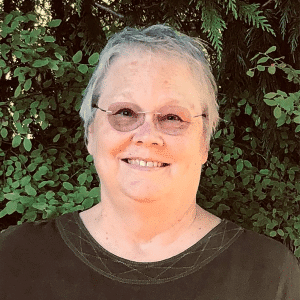
Start Early Washington shares our collective love, respect and appreciation for Quen Zorrah and her lifetime of work supporting human connection and relationship building between children and their caregivers. Her expertise in supporting families has shaped how programs work with families to promote strong relationships.
Raising the Bar
Prior to her time with Start Early Washington, Quen was a public health nurse and one of the first nurses in the nation to provide home visiting services to families through Nurse-Family Partnership. Her work has integrated infant mental health and Neuroscience, Epigenetics, ACEs, and Resilience (NEAR) science into home visiting through teaching, coaching and reflective supervision. As the Lead Facilitator and Co-Developer of NEAR@Home, Quen has developed trauma-informed practices for building resilience and uniquely positions home visitors to safely and effectively talk with families during a critical period of development – the earliest years of a child’s life.
“I was fortunate enough to work with Quen for 20 years, as a teacher, supervisor, consultant, co-author and an esteemed colleague. I’ve never known anyone who got what reflective listening was, or who was freer of professional pretense, than Quen. She is so unpretentious that it would be easy to underestimate her real genius for this work.” — Dr. Marian Birch, DMH, Psychologist
The Journey
Like many staff on Start Early Washington’s home visiting team, Quen’s firsthand experiences as a mother led her to pursue a lifelong career devoted to children and their families.
At the age of 19, Quen distinctly remembers the first day she met a home visitor. “My child was only two days old when a woman from King County Public Health knocked on my door. She was so humble and respectful, but as persistent as a boot wedged in my doorway! Somehow, she knew how much I needed to hear words of compassion.” Seemingly, Quen’s home visitor intuitively knew that Quen was in need of positive reinforcement and support as a young, first-time parent.
Quen admired the compassion and hopefulness home visitors brought to her life, but she was still apprehensive at the thought of home visiting with her second child. “I wasn’t as put together and I was worried about what they would think of me, my mess and my reality.” Unsurprisingly, her home visitors lauded her efforts and bolstered her confidence, helping her tackle the many challenges of parenting. With each visit, Quen’s self-talk started to shift substantially, “College is achievable!” “My voice matters!” “I can do this!”
Quen’s home visitors changed the course of her life. “Not only my life but my kids’ lives as well. We take for granted the power of finding strengths and being human with each other.” After witnessing the power of home visiting support, Quen was determined to make a difference to others just as her home visitors did for her; she was determined to be a catalyst for change.
Quen completed her GED and carried her remarkable determination and fortitude as a young parent with her to nursing school at Seattle Central Community College. Upon graduation, Quen worked as a nurse for renowned medical centers and rural based community hospitals in remote mountain towns, before joining Nurse-Family Partnership, where she flourished for the next 20 years, supporting families with young children, pregnant women, grandparents, foster parents and fathers as primary caregivers.
Quen’s passion and perseverance to provide comfort, compassion and support led her to the creation of the highly successful, nationally acclaimed NEAR@Home toolkit, a tool providing home visitors with information and skills to talk about trauma and Adverse Childhood Experiences (ACEs) during home visits, while building trust and hope.
“Quen reminds me that I do not always have to fix things; my presence alone can bring value to any given situation.” — Amy Houser, Consultant
Finding Balancing
Home visitors often face their own challenges with trauma and Adverse Childhood Experiences (ACEs). These lived experiences bring motivation and strengths to the field of home visiting, but they also add another level of strain. The exposure to challenges and trauma of others can contribute to burnout and poor mental and physical well-being. Quen notes gardening as her antidote to secondary traumatic stress or “compassion fatigue” inherent to those supporting families directly.
Quen appreciates the balance that gardening brings to the intensity of her work. Influenced by her great-grandmother, Quen cherishes time outside to slowly walk around her garden and admire each of her plants. “Gardening is a wonderful balance to all seriousness. It’s creative and offers exercise and most importantly, if I mess something up in my garden, I just compost it. But of course, it’s not that simple with humans. With plants, the worst that will happen is a compost pile.”
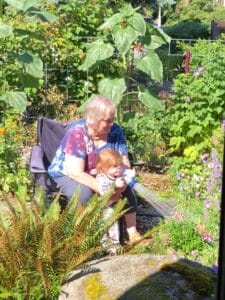
“Quen’s thoughtfulness, reflectiveness, kind, calm and peaceful way of being, is something I strive to incorporate into my work and personal life.” — Amanda Costello, Director of National Home Visiting, Start Early
Home visiting stories of success and triumph were also a grounding element for Quen. She recalled all the knowledge accumulated over the years: “That’s what kept me going for so long. When working long hours or flustered with bureaucracy, budgets and funding, I’d think about the stories we accumulated. My hope for home visitors is that they will share stories for inspiration and as a guide to move past challenges together.”
A Career to Remember
“Quen has shown me how to focus on people and building relationships before focusing on the work.” — Valisa Smith, Executive Director, Start Early Washington
While Quen may no longer be part of the thick of home visiting life, her profound impact has left a lasting legacy, disrupting the way we interact with each other by offering tools that will transform how we build and foster relationships for generations to come.
I’m hoping some of our systems are at a pivot point and we reach a balance where we can value community voice, recognizing that parents know exactly what they need, as much as we value data.
— Quen Zorrah
Start Early Washington is proud to be part of Quen Zorrah’s story. Her ability to reach parents and children at an intrinsic human level is immeasurable. We are honored to continue to share NEAR@Home with the world – a toolkit designed to allow users to rediscover hope and strive toward healing, fostering strong and healthy relationships.
We thank Quen for her incredible contribution to the field, honor her on all she has accomplished in her professional and personal life, and congratulate her on retirement and her future endeavors.
Stay Connected
Sign up to stay up to date on latest in early learning and home visiting programming in Washington state.
Washington State Hub
Learn more about our work in Washington state and access relevant resources and publications.
Resources for Professionals
From interactive courses to engaging events, we support educators in building powerful practices that transform teaching and learning.
Brenda Smith has taught at Educare Chicago, a program of Start Early, for 13 years. In that time, she’s seen first-hand how providing for the needs of families can uplift not only her students, but the communities in which they live.
Every Child Deserves a Quality Education
Support Start Early and help us continue to build and offer quality programs, like Educare, to children and families living in under-resourced communities.
“We had one child whose mom was actually homeless… We treated them with so much care and love that when she came in, she would just stay the whole day,” Brenda says.
The student’s mom spent most of the day in the Educare Chicago Family Center, a space that gives parents access to a computer lab, family resource library and conference rooms. At the Educare Chicago Family Center, program staff made a point to connect with the mother and began building a meaningful, trusting relationship.
“She always came in when she brought him,” says Brenda. “She made sure he came to school… when she wasn’t coming, she would call us. We felt like she had really made us a part of her family.”
I’ve been in this field for a long time, and I have never been at a center that cared as much and had the same amount of compassion for its parents and families as Educare Chicago.
Brenda Smith, Educare Chicago teacher
The team at Educare Chicago worked to identify the family’s needs and address them as much as possible. Start Early’s quality early childhood programs often help families access community services that they might otherwise not be aware of or are otherwise unable to use because of systemic barriers.
“We made sure that she was able to get him here,” Brenda explains. “We provided her with carfare. We gave her gift cards to get things that she might’ve needed, that she wouldn’t have been able to receive if she wasn’t here.”
Mental health consultants and family support specialists on staff also worked with the student’s mom, connecting her to a wide range of supportive services.
“We had wonderful mental health consultants that took care of her, mentally and emotionally, in ways that us, the teachers, couldn’t,” adds Brenda.
After her son graduated from the program, the mother continued to occasionally visit Educare Chicago’s campus and provide the team with updates on her life.
“She has her own apartment now, and she has a job now,” says Brenda. “We provide our parents with so much information and so much family support.”

Donate by 12/31: Every Child Deserves a Quality Education
For over 40 years, Start Early has provided doula, home visiting, and Head Start programs while advocating for policies and adequate funding to make quality early education programs, like Educare Chicago, accessible to communities across the nation. Support Start Early today and help us continue to build and offer quality programs to children and families living in under-resourced communities.
Partnering with parents and connecting them with services and resources to help understand their children’s developmental needs is a core component of Educare Chicago’s approach to ensure students grow up healthy, supported by their families and ready to learn.
“We have a program that links parents up with other organizations,” Brenda says. “These organizations help them if they want to go to school, if they have loans that are overwhelming them, if they need a car, if they need somewhere to live, if they need furniture… They provide that kind of help for our parents.”
The focus on providing for parents and families at Educare Chicago is indicative of the support that well-resourced early childhood learning programs can provide. Brenda, who worked at several daycare centers prior to her work with Educare Chicago, says that this approach makes a significant difference in the educational and social outcomes of its students.
“I’ve been in this field for a long time, and I have never been at a center that cared as much and had the same amount of compassion for its parents and families as Educare Chicago,” she says.
Why Early Childhood
Quality early childhood is one of the best ways to level the playing field. Learn why and about the impact we’re having.
Support Our Work
Together, when we start early, we can close the opportunity gap and ensure every child has a chance to reach their full potential.
Our Impact
Learn more about how we are supporting children, families and early childhood professionals as we improve the state of early learning in America.
There’s been a national discussion about increasing our aptitude in the fields of science, technology, engineering and math (STEM)/science technology, engineering, arts and math (STEAM). America is underperforming other industrial nations, and these areas are increasingly playing a critical role in career success.
Much of the conversation focuses on improvements in the middle and high school years. But we can begin building STEM/STEAM skills much earlier than that—as soon as a child starts speaking.
Stay Connected
Sign up to receive news, helpful tools and learn about how you can help our youngest learners.
Some young children are innately interested in: learning how things work, building things and taking things apart. But all children can be enticed into STEM/STEAM learning through whatever they’re already interested in. Both STEM and STEAM support play, wonder and curiosity; but STEAM includes an art component that allows children to create and design with intention. STEM and STEAM encourage children to solve problems by using inquiry and investigation.
Since young children tend to ask lots of questions, you can introduce STEM/STEAM basics by following these simple “CHIA” steps:
- Curiosity: “So glad you asked!”
- Hypothesis: “Why don’t you make a guess?”
- Investigation: “Let’s look into it!”
- Analysis: “Why do you think that happened?”
Before beginning any activity with your toddler, ask them what they think is going to happen. Then ask why they think that. They’ve just created a hypothesis and given their logic for that hypothesis—the foundation of all scientific exploration. By then creating experiments with your toddler and talking about what you observe, you’re setting them up to plan, brainstorm, build, and solve problems exactly like scientists and engineers do.
Ideas for You and Your Child:
- Build a ramp for toy cars to roll down. Have your toddler race two cars down the ramp. Ask them to predict which one will get to the bottom first. Then have them play with how to make the cars faster or slower. For example, if you put a small stone on the car, does it make it go faster? Buildable toys provide great opportunities for experimentation. What happens to the speed when your toddler makes the car bigger, heavier, or longer? This is experimentation, and it’s fun!
- When you go for a walk, you can guide the conversation, or let your child come up with their own experiments. If you see an animal, play with how softly you can talk before the animal notices you. Or ask your child why the squirrels race around the tree. Right answers are not the goal—this is about asking questions and predicting the answer.
Remember that it’s okay for both you and your child to answer “I don’t know” to any question. It’s asking the question that’s important because that is where all science begins.
STEAM At-Home Activity: Building Structures
While at home, parents can introduce building structures with their children. The materials for this activity consist of wide popsicle sticks, clear plastic drinking cups and small cube blocks. Parents can encourage their child to build a structure while engaging in conversation about how many cups will it take to build the structure. What will happen if you use fewer cups and more popsicle sticks? How high can you build? The children can learn about balance, height, measurement and a host of wonderful things. This at-home activity needs little to no planning, but a readiness to think outside of the box.
Don’t underestimate the incredible thinking skills that young children have. With just a playful shift in word choice, we can allow for a dramatic shift in getting our babies ready for a STEM/STEAM education!
More Like This
Take Action
Raise your voice and encourage lawmakers to prioritize early learning and care at the local, state and federal level.
Support Our Work
Together, when we start early, we can close the opportunity gap and ensure every child has a chance to reach their full potential.
Resources for Families
Discover educational activities and resources from Start Early experts to provide easy and engaging educational experiences with your child.
When a young student began drawing pictures using only black crayons, it caught the attention of veteran early childhood educator Alyia Dixon.
“Kids always gravitate to the brighter colors,” Alyia says. “But when she was scribbling, she scribbled her pictures all in black… Sometimes all black, all the way to the edge of the pages.”
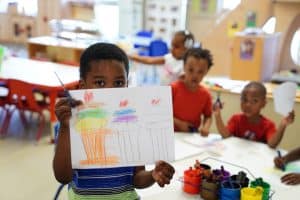
Alyia, who has been teaching at Educare Chicago, a program of Start Early, for 23 years, shared her observations and concerns with the school’s family support specialists, and together, they arranged a visit to the student’s home. These sorts of discussions are critical for providing families with a multi-perspective and multi-expertise support system. This holistic approach is a core component of high-quality early childhood programs. It provides valuable support for students and can help connect their families to important resources.
Support Our Teachers
Give a gift that will ensure teachers like Alyia have the resources needed to support young children and families in powerful and life-changing ways.
“We did a home visit and found out that her lights were out… That’s why she was drawing all in black,” Alyia explains. “After we realized that, we talked about things you could do in the dark, you know, to try to lessen the negativity behind having the lights out.”

The Educare Chicago team realized during the home visit that the family was living with relatives, and that they would be best suited for success if they had their own apartment.
The school’s family support specialists worked with the student’s mother to help her obtain her own housing and connected her with utility payment assistance programs.
At Start Early, we believe that parents are a child’s first educators, which is why we prioritize family engagement in our early learning programs. Family engagement in early education is particularly important for children and families in communities that are under-resourced, in that it helps create consistency between the home and school environments. The positive outcomes of engaged parents are powerful: increased support for children’s learning at home, empowered parents and improved family well-being.
When Alyia reconnected with the family several years later, she discovered that they were still successfully living on their own.
“We were talking and she brought up how embarrassed she had been during that home visit,” Alyia says. “But, she said, ‘We only had candles and you acted like it was nothing. That took away the sting of it… I knew then that it was going to be all right.’”
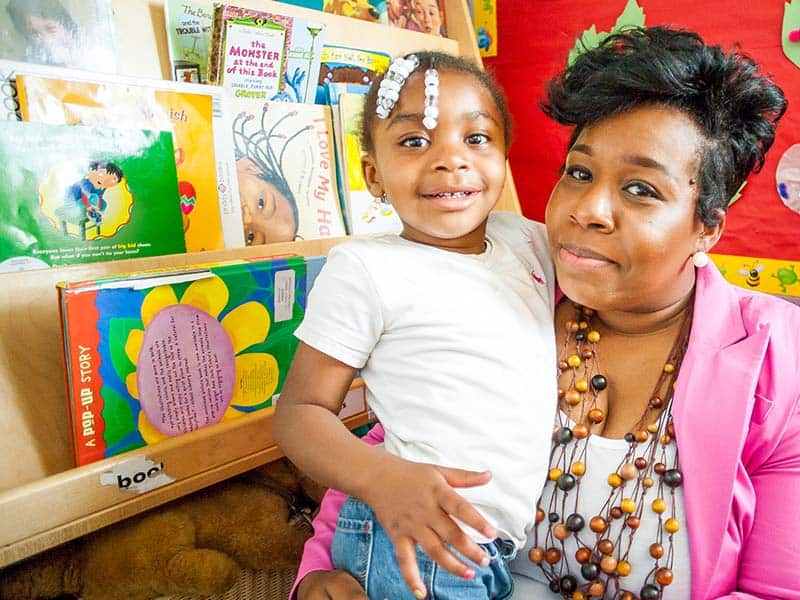
Support Our Teachers
For 40 years, Start Early has provided doula, home visiting and Head Start programs while advocating for policies and adequate funding to make high-quality early education programs, like Educare Chicago, available in communities across the country. Supporting our vital work ensures that teachers like Alyia have the resources needed to support young children and their families in powerful and life-changing ways.
The supports available through our high-quality early childhood programs don’t just provide for the needs of students while they’re in the classroom; they also address challenges at home that could keep a student from thriving in pre-kindergarten and beyond.
“A lot of the circumstances we witness go way above and beyond the norms for what a teacher is supposed to encounter,” Alyia says.

That’s why high-quality early childhood programs often rely on experts that can help families connect with mental health resources, find safe housing and obtain food assistance. At Educare Chicago, family support specialists and mental health consultants work diligently with parents to ensure the needs of their entire family are being met.
Additionally, our programs connect parents of young children with their peers, creating supportive communities that benefit both adults and their kids.
“Our parents build relationships with other adults that they maintain outside of Educare Chicago. We’ve had a few parents that built relationships where they would take their kids on outings with each other,” Alyia says. “They’re building relationships and making connections that will outlast their child’s time in our program.”
Why Early Childhood
Quality early childhood is one of the best ways to level the playing field. Learn why and about the impact we’re having.
Support Our Work
Together, when we start early, we can close the opportunity gap and ensure every child has a chance to reach their full potential.
Our Impact
Learn more about how we are supporting children, families and early childhood professionals as we improve the state of early learning in America.
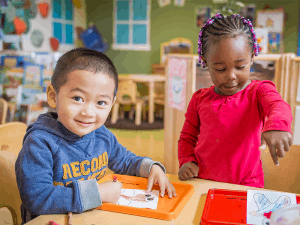 Parents in Chicago often enroll their children ages 3-5 in community-based organizations because they love and trust their local early learning program and because the program provides more convenient hours and comprehensive, year-long services for families. With support from Crown Family Philanthropies, Start Early launched a new initiative this summer in partnership with Chicago Public Schools (CPS) and Chicago’s six federally funded Head Start grant recipients to make special education services more accessible for the city’s children ages 3-5 who are enrolled in community-based Head Start programs.
Parents in Chicago often enroll their children ages 3-5 in community-based organizations because they love and trust their local early learning program and because the program provides more convenient hours and comprehensive, year-long services for families. With support from Crown Family Philanthropies, Start Early launched a new initiative this summer in partnership with Chicago Public Schools (CPS) and Chicago’s six federally funded Head Start grant recipients to make special education services more accessible for the city’s children ages 3-5 who are enrolled in community-based Head Start programs.
Currently in the city of Chicago, special education services are not provided in community-based settings where many children are enrolled. Instead, children attend both their community-based program and a school-based program, which involves bus rides and multiple transitions between classrooms in one day. Some parents who rely on community-based settings for early learning may forgo these services that their child needs to avoid distress and challenging behaviors that can follow the multiple transitions.
Even when children receive their special education services in a CPS classroom, those supports do not follow them to their community-based setting. This leaves children unable to fully access and participate in the classroom and it leaves teachers without the support they need to ensure the best quality educational experience. As a result, children may experience barriers to healthy development. The current system also poses long-term challenges for CPS as they work to ensure equitable access to special education and kindergarten readiness for all students.
Support Our Work
Together, when we start early, we can close the opportunity gap and ensure every child has a chance to reach their full potential.
The goal of this project is to ensure access to inclusive special education services for all children with disabilities enrolled in community-based early childhood programs in Chicago. To this end, we are working in partnership with families and educators to develop, implement, assess, and institutionalize feasible strategies and approaches for delivering special education services to children with Individualized Education Plans (IEPs) onsite in the Head Start programs in which they are enrolled.
Start Early staff are nationally recognized leaders in special education for young children. Learn more about Start Early’s recommendations for strengthening early childhood inclusion for young children with disabilities, and contact us to learn how you can support high-quality, accessible education for all young children.
The Crown family has worked for decades alongside Start Early to increase access to equitable, high-quality early education and care for all children and families in Chicago, including recent support for the launch of Every Child Ready Chicago, a public-private partnership to support access to high-quality early childhood education in the city.
Start Early remains grateful to Crown Family Philanthropies as we champion early learning and care and close the opportunity gap for our youngest learners.
More Like This
Our Impact
Learn more about how we are supporting children, families and early childhood professionals as we improve the state of early learning in America.
Support Our Work
Together, when we start early, we can close the opportunity gap and ensure every child has a chance to reach their full potential.
Get Involved
Inequity starts at birth, and that impact lasts a lifetime. Get involved with Start Early and help us change the course for our youngest learners.
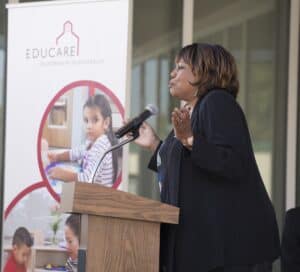 After a career in early childhood education spanning three decades, Portia Kennel – catalyst and one of the co-founders of the Educare Learning Network, a powerful network of birth-to-five schools that has improved access to high-quality early education across the country – is retiring from her position as Senior Advisor to the Buffett Early Childhood Fund.
After a career in early childhood education spanning three decades, Portia Kennel – catalyst and one of the co-founders of the Educare Learning Network, a powerful network of birth-to-five schools that has improved access to high-quality early education across the country – is retiring from her position as Senior Advisor to the Buffett Early Childhood Fund.
Prior to her time with the Buffett Early Childhood Fund, Portia served as the Senior Vice President of Program Innovation at Start Early (formerly the Ounce of Prevention Fund). In 2000, she created the first-ever Educare school in Chicago to serve young children and their families on Chicago’s South Side. As the Executive Director of the Educare Learning Network, Portia led the expansion of the Educare model to a diverse range of communities across the country, from one school in Chicago to 25 schools nationwide.
Stay Connected
Sign up to receive news, helpful tools and learn about how you can help our youngest learners.
“Portia’s passion and commitment to serving children the last several decades have helped shape Start Early into the organization that we are today,” Diana Rauner, Start Early President and longtime colleague of Portia, shared. “Her drive, perspective and guidance continue to resonate through the halls of our offices and within the values that inform our work. I am so proud of what we created together through the Educare Learning Network, and I believe that the best is yet to come thanks to her foundational presence. The early learning community is grateful for Portia, and we wish her well in this next chapter of life.”
Portia's passion and commitment to serving children the last several decades have helped shape Start Early into the organization that we are today.
Diana Rauner, president, Start Early
Portia is also a former Head Start Director and has significant experience in the design, implementation and management of effective, evidence-based early childhood education and family support program models. Her work is grounded in an understanding of family systems and clinical issues related to working with families in disinvested communities. She holds a master’s degree in social work from the University of Illinois at Champaign-Urbana and is a ZERO TO THREE Fellow.
“We’re so grateful to Portia for her contribution to the early childhood field broadly, and to the Educare Learning Network specifically,” Cynthia Jackson, Executive Director of the Educare Learning Network and Senior Vice President at Start Early, said. “Twelve years ago, Portia invited me to serve as a leader of leaders in this Network. I am so grateful to have had the opportunity to serve under an African American woman, mentor, teacher, visionary and colleague. Thank you, Portia – from the Network and from me personally. What an innovator you have been.”
Start Early and the Educare Learning Network congratulate Portia on a remarkable career and thank her for the groundbreaking legacy in early childhood education she started with our Network!
Portia Kennel’s Parting Remarks
What a journey this has been! Reflecting on the early days of Educare, my mentor Judy Bertacchi comes to mind. Judy was a pioneer leader in training early childhood staff how to implement and embed reflective supervision into early childhood programs. She always said how important it was to “get the birth story” of each child because it would inform the work you’d do with the family. So, today I am going to share the birth story of Educare, because I believe it will inform the future as the Network goes forward.
The idea for Educare grew out of The Beethoven Project, an initiative began by Start Early (then the Ounce of Prevention) in 1986 to bring early learning programs and other services to communities in Chicago’s Grand Boulevard neighborhood on the south side. At that time, this neighborhood was home to the Robert Taylor Homes, which was one of the largest public housing developments in the poorest census tract in the country.
When the Chicago Housing Authority began demolishing the Robert Taylor Homes in the late 1990s, many families began leaving the community as public services started to vanish. I have never seen so many thousands of families disappear what seems like overnight. But we decided we were in it for the long haul, and we stayed. It was very important to us, since so many institutions were abandoning these families, that they knew we would not abandon our commitment to them.
That’s why we started building our own early childhood education center: to serve families who were displaced by the loss of their homes and now rebuilding their community, and to create a school whose culture and environment said – and still to this day says – “You matter.” So, we partnered with the city of Chicago, the Office of Head Start, and other private funders to build our first school, Educare Chicago, which we opened in 2000.
And Educare Chicago was just the beginning! Fast forwarding two decades to now, that first school inspired the creation of the Educare Learning Network, 25 schools across the country that are models for high-quality care and education in their communities and nationwide.
I led the expansion of our Network from one school to many for three reasons: to learn from each other, to support each other and problem solve together, and because I hoped that by coming together, our collective power would have a better chance of addressing challenges in the field. What we had in common was a shared interest in showcasing quality in our communities through Educare schools, demonstrating what is possible with services for children and families, and increasing our impact as catalysts for positive change. In other words, I believed we could do more together than any of us could do alone. And in today’s world, our critical work is to continue to harness and leverage the collective power of the Educare Learning Network to transform the early childhood world.
As I now leave the Network, my first hope is that you will increase your collective impact and efforts. The Network has yet to realize its full potential. We all agree changes are needed to address the systemic issues that have plagued the early childhood system for so long: quality, access, workforce recruitment, retention, racism, compensation and more, many of which have been amplified by the pandemic.
My second hope for the future is that in addition to an ongoing focus on racial equity, the Network will prioritize efforts to ensure the systematic and sustained inclusion, participation and leadership of parents in the planning, development, decision-making, implementation and evaluation of early childhood work. That means centering and elevating the voices of parents to ensure their lived experiences inform and help address the challenges the early childhood system faces. As Glenn Martin of JustLeadershipUSA says, I believe those closest to the problem are closest to the solution. Investing in parent leaders as early childhood advocates and change agents strengthens our chances for success.
We’re all in this together: parents and families, early childhood leaders, educators, family support practitioners, childcare providers, policymakers, advocates, public and private partners, and communities. We must work together to find solutions.
I thank all of you for what I have learned from you. I thank Jessie Rasmussen and the Buffett Early Childhood Fund, Diana Rauner and Start Early for all they have done to support the continued growth and development of the Educare Learning Network. The Network would not have been possible without the partnership and support of both organizations, and of course the participation of all of you early childhood champions.
Go forth, Educare Learning Network, and cause some good trouble!
More Like This
Early Learning Programs
We work on-the-ground in Chicago and partner with others to bring lessons learned to children and families nationwide.
Support Our Work
Together, when we start early, we can close the opportunity gap and ensure every child has a chance to reach their full potential.
Our Impact
Learn more about how we are supporting children, families and early childhood professionals as we improve the state of early learning in America.

